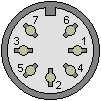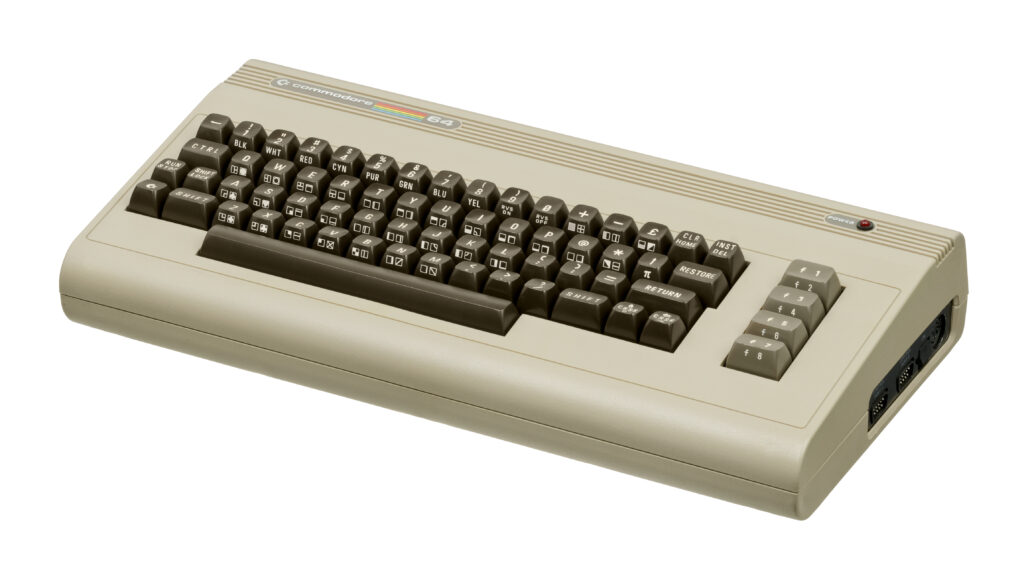Commodore 64 (Breadbin) Common Faults
An excellent guide found at https://retroleum.co.uk/. My goto site for ZX spectrum and Commodore parts. Excellent advice and first class service.
From the outset, it should be noted that a (working) Commodore 64 will still boot to the familiar blue border without the following components – though it may not be responsive.
- Keyboard
- Power LED
- SID 6581 (U18) Chip
- CIA 6526 chip at U1
- Character ROM (U5) but the non-border display will just be fizzy pixels.
- And usually the 6526 CIA at U2 (random effects may occur)
(The C64 should not be harmed by doing this)
First things first..
- Make sure the PSU is OK – the original Commodore PSUs should output about 5.0 to 5.3v DC and 10-11v AC. Here is a digram of the pinout viewed froom female side:

- Pinout
- 1 GND Ground/Not connected
- 2 GND Ground
- 3 GND Ground/Not connected
- 4 – N/A 5V or Not connected
- 5 + 5V DC 1.5 A 5 Volt direct current
- 6 9V AC1 1.0 A 9 Volt alternating current phase 1
- 7 9V AC2 1.0 A 9 Volt alternating current phase 2
- Check that the C64’s internal fuse has not blown (a break will be usually be visible, but use a multimeter across it on continuity mode to make sure).
- Make sure the power switch is good (it is a double pole type, so it can half-fail as well as become high resistance etc). Disconnect the power plug, put the C64’s switch on and with the meter on its lowest Ohm range, the power switch on-resistance (between the lower centre pin and the lower pin next to the body of the switch) should not be distinguishable from shorting the multimeter probes. Same for the upper centre pin and upper pin next to the body of the switch.
- Check the logic supply is good: EG pin 16 of U14 should be 4.75 to 5.25v (note this 5v supply comes direct from the PSU / switch and is not that supplied by the regulator VR2.
- Check the voltage regulators’ inputs / outputs:
VR1 should be:
~17v GND 12V
.. and VR2 should be:
5V
GND
~10V
- Visually inspect the board for past repairs.. which may not have been quite up to scratch.
“Out of memory error” on boot..
You almost certainly have bad RAM (one or more of the 4164s, ie: U9-12, U21-24) – without a test cartridge it can be tricky to know which is bad but piggybacking a good 4164 over each chip in turn may be enlightening (or of course you could just replace them all). Naturally, there could be other faults too.
Video Issues…
Video is black and white (monochrome).
- Assuming the C64 is actually the correct model for your TV system (PAL/NTSC) try adjusting the trimmer pot next to the VIC-II chip (R27), if still no good suspect the TV modulator or VIC-II chip.
Poor video quality on RF:
- Check with another RF cable – they can degrade.
- Replace TV modulator,
Poor / no video on AV port (but RF works, or computer responds when typing blind – EG: You can load a tape with SHIFT+RUNSTOP)
- Bad modulator (it contains through paths for the AV port as well as doing RF stuff)
- Video DIN socket bad.
On RF, white video flares in the display, or entire image looks dull
- Adjust the trimmer pot in the modulator.
On boot, the character colour attributes are flickery but everything else seems fine
- Replace the 2114 colour RAM (U6)
When the system has been on a while, there are pixel glitches within sprites (usually along the left side) or disruption / wrong colours in certain modes (bitmap mode for example – play Cybernoid II) :-
- Replace the VIC-II chip (U19)
Timing / TV sync problems (wibbly display etc)…
- Usually one of the VIC-II support ICs on ealry boards (U29,30,31,32) will be bad.
C64 powers up and works, but the characters are all messed up (random patterns)
- Bad character ROM at U5
Sound issues..
Garbled sound, missing sound channels, complete silence:
- The fault will usually be a bad SID chip, especially the 6581 version from the breadbin c64 (and VERY early transitional C64C with larger PCB). However, always make sure the voltages supplied to the SID chip are correct – there should be 12v at pin 28 (9v for the 8580 SID in the C64C) and 5v at pin 25. If the voltage at pin 28 is bad, check the 7812 regulator (or Q5, CR7 in the C64C), power switch, power socket and PSU.
(Of course, the SID’s sound filters always varied so things sounding slightly different may not automatically indicate a fault.)
THE BIG ONE: Black screen on power on..
Apart from SID issues, this is the #1 C64 fault. It’ll usually be caused by a bad PLA (U17) or 6510 (U7) as they run the hottest and will have been most stressed – however – practically any chip on the PCB can cause this fault (as can dry joints, cracked PCB traces, poor chip sockets). Some quick tests can usually be done without any spare parts: If they’re in sockets, remove the SID chip (U18) and CIAs at U1+U2, and power up – if it still shows the black screen on boot, the following chips are chief suspects in order of likelihood: PLA (U17). 6510 (U7), VIC II (U19), KERNAL (U4) – after this, we’re kind of in the weeds because any of the discrete logic chips or RAM chips could be bad. Instead of randomly replacing chips, it may be more time-efficient to get a replacement board that is known to work but requires the main chips (especially if you’re lucky enough to have the main chips in sockets). More info can be found in the service manual’s fault-finding section. An external diagnostic ROM cartridge may also shed some light on things.
Input/Ouput problems…
Keyboard intermittent – certain keys require a lot of force to register.
- The keyboard should be disassembled (you need to desolder the wires from the keylock switch first) so that all the rubber contacts and back panel PCB contacts can be cleaned with isopropyl alcohol. Sometimes impact marks on the gold pads need to be removed with the blue end of a pencil eraser (don’t do this if the PCB pads are carbon coated – just clean them with isopropyl alcohol). Occasionally the pads or rubber contacts are so worn that no amount of cleaning will cure the issue 100%
Regular patterns of keys don’t work.
- This will usually be caused by a bad 6526 CIA at U1, or could be a bad keyboard cable or connector.
Certain joystick directions don’t work
- Assuming the joystick port pins are clean (and there’s no dry solder joints… and the joystick is known to be good:) this will usually be down to a bad CIA at U1
Communication issues..
Always “Device not found error” or hangs when accessing serial port (ie: disk drive)
- Bad 6526 CIA at U2 or Bad 7406 (U8)
Games never load, even with a known good tape + C2N.
- Suspect the CIA at U1 or 6510 (U7)
Replacing chips with later versions:
A higher revision VIC-II chip should be fine in a board which originally had a lower version, at least, no damage should occur. However you cannot directly use a VIC-II chip from a C64C (eg: a 8562) in a breadbin C64 because the C64C VIC-II requires just 5 volts whereas the earlier chips use 5 volts and 12 volts. The 8562 chip will be destroyed if powered up in a unmodded breadbin board.
Similarly, you cannot directly replace an 6581 SID chip with an 8580 SID from a C64C (the 8580 SID uses 9v and 5v, whereas the 6581 uses 12v and 5v)
However, you can replace the breadbin’s 6510 CPU with an 8500 from a C64C, and you can use 6526A CIAs often found in C64C in breadbins.
Finally – a few “non-faults”
1. Vertical light or dark banding / alternate columns of text have a slightly different hue. This is normal for PAL C64s and seems to vary from one machine to another. The effect can be less noticeable when a SCART connection is used, especially if it supports S-Video. A “Luma Fix” mod board is available which may reduce the effect.
2. Fine checker board pattern to display / slight horizontal offset to pixels every other line. As above, this is normal for PAL C64s. Again, the Luma Fix board may help.
3. When scrolling up and down files with the “FB” file browser (EG: when using the SD2IEC) , the text colours mess up. This is caused by a known issue with 901227-01 / 901227-02 KERNAL ROMs (specifically: the clear screen routine doesn’t fill the colour attributes with the active character colour). The 901227-03 KERNAL ROM does not have this “bug”.
4. On earlier C64s, the first time you access the serial port with the SD2IEC you get “Device not found” – later C64s boards removed the reset line from the serial port and this seems to stop this happening.



